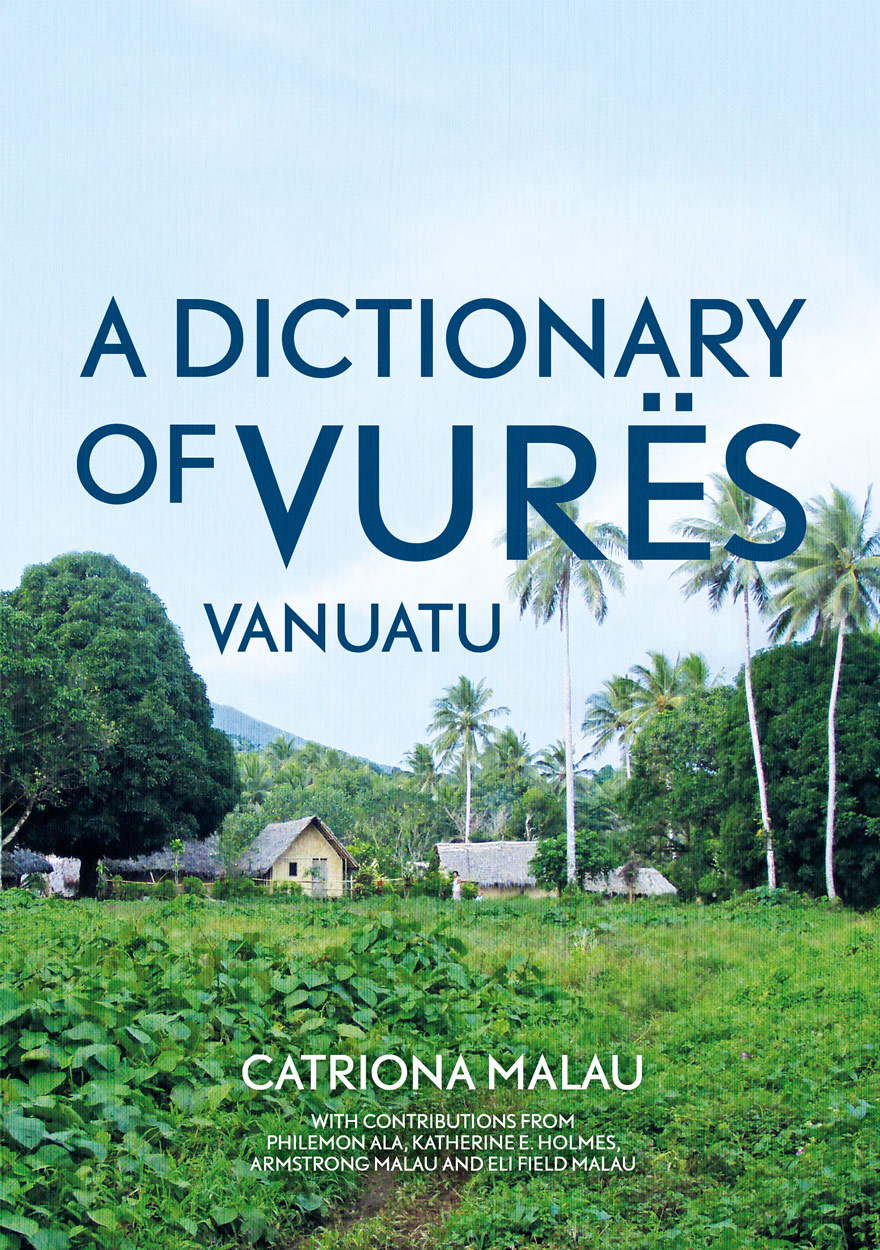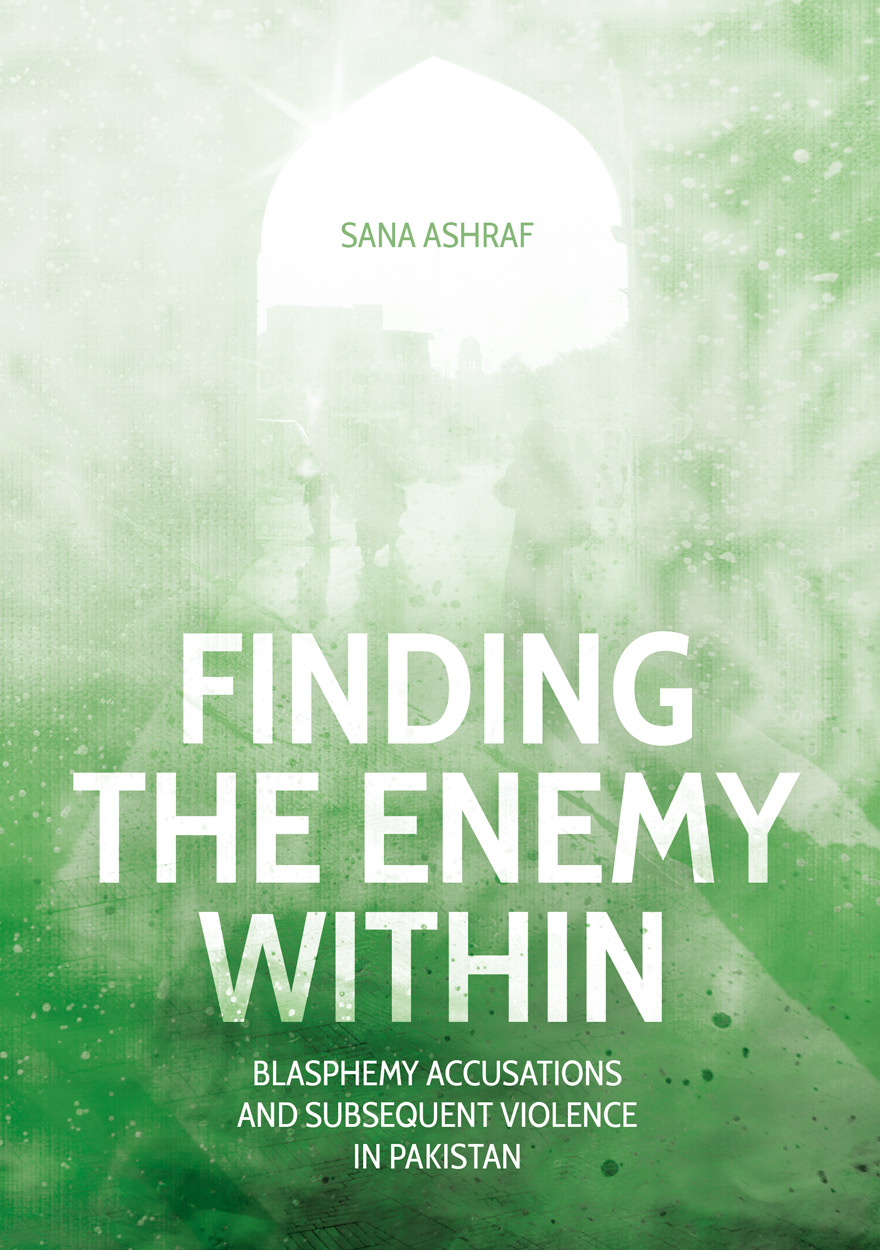Search titles
Displaying results 101 to 110 of 628.

A Dictionary of Vurës, Vanuatu »
Authored by: Catriona Malau
Publication date: September 2021
This is a trilingual dictionary of Vurës, with meanings provided in both English and Bislama, the national language of Vanuatu. Vurës is an Oceanic language spoken on the island of Vanua Lava in Vanuatu. The dictionary is a companion volume to A Grammar of Vurës, Vanuatu (Malau 2016). There is no established tradition of writing in Vurës and most speakers are not literate in their own language. This dictionary is intended to have a dual purpose: to support the learning of literacy skills in the Vurës community, and as a reference work for linguists.
There are four parts to the dictionary. The main part is the most comprehensive and provides the English and Bislama definitions of Vurës words, as well as example sentences for many of the entries, additional encyclopaedic information, scientific names for identified species, lexical relations, and etymological information for some entries. The dictionary contains approximately 3,500 headwords and has a strong emphasis on flora and fauna with close to a third of the entries belonging to these semantic domains. The dictionary has benefited from collaboration with a marine biologist and botanists, who have provided scientific identifications for named species. The main dictionary is followed by English–Vurës and Bislama–Vurës finderlists. The final part of the dictionary is a thesaurus, in which Vurës words are grouped according to semantic categories. The thesaurus has been included primarily so that it can be used to support teaching of literacy skills and cultural knowledge within the community.

The Federated States of Micronesia’s Engagement with the Outside World »
Control, Self-Preservation and Continuity
Authored by: Gonzaga Puas
Publication date: September 2021
This study addresses the neglected history of the people of the Federated States of Micronesia’s (FSM) engagement with the outside world. Situated in the northwest Pacific, FSM’s strategic location has led to four colonial rulers. Histories of FSM to date have been largely written by sympathetic outsiders. Indigenous perspectives of FSM history have been largely absent from the main corpus of historical literature. A new generation of Micronesian scholars are starting to write their own history from Micronesian perspectives and using Micronesian forms of history. This book argues that Micronesians have been dealing successfully with the outside world throughout the colonial era in ways colonial authorities were often unaware of. This argument is sustained by examination of oral histories, secondary sources, interviews, field research and the personal experience of a person raised in the Mortlock Islands of Chuuk State. It reconstructs how Micronesian internal processes for social stability and mutual support endured, rather than succumbing to the different waves of colonisation. This study argues that colonisation did not destroy Micronesian cultures and identities, but that Micronesians recontextualised the changing conditions to suit their own circumstances. Their success rested on the indigenous doctrines of adaptation, assimilation and accommodation deeply rooted in the kinship doctrine of eaea fengen (sharing) and alilis fengen (assisting each other). These values pervade the Constitution of the FSM, which formally defines the modern identity of its indigenous peoples, reasserting and perpetuating Micronesian values and future continuity.

Finding the Enemy Within »
Blasphemy Accusations and Subsequent Violence in Pakistan
Authored by: Sana Ashraf
Publication date: September 2021
In the past decade, Pakistan has witnessed incidents such as the public lynching of a student on a university campus, a Christian couple being torched alive, attacks on entire neighbourhoods by angry mobs and the assassination of a provincial governor by his own security guard over allegations of blasphemy. Finding the Enemy Within unpacks the meanings and motivations behind accusations of blasphemy and subsequent violence in Pakistan.
This is the first ethnographic study of its kind analysing the perspectives of a range of different actors including accusers, religious scholars and lawyers involved in blasphemy-related incidents in Pakistan. Bringing together anthropological perspectives on religion, violence and law, this book reworks prevalent analytical dichotomies of reason/emotion, culture/religion, traditional/Western, state/nonstate and legal/extralegal to extend our understanding of the upsurge of blasphemy-related violence in Pakistan.
Through the case study of blasphemy accusations in Pakistan, this book addresses broader questions of difference, individual and collective identities, social and symbolic boundaries, and conflict and violence in modern nation-states.

Linguistic Organisation and Native Title »
The Wik Case, Australia
Authored by: Peter Sutton, Kenneth Locke Hale
Publication date: September 2021
Classical Aboriginal societies in Australia have commonly been described in terms of social organisation and local organisation. This book presents rich detail on a third and related domain that has not been given the same kind of attention: linguistic organisation.
Basing their analyses on fieldwork among the Wik peoples of Cape York Peninsula, north Australia, Peter Sutton and Ken Hale show how cosmology, linguistic variation, language prehistory, clan totemic identities, geopolitics, land use and land ownership created a vibrant linguistic organisation in a classical Aboriginal society.
This has been a society long in love with language and languages. Its people have richly imbued the domain of rights and interests in country—the foundations of their native title as recognised in Australian law—with rights and interests in the abundance of languages and dialects given to them at the start of the world.

Creative Frictions »
Arts Leadership, Policy and Practice in Multicultural Australia
Authored by: Cecelia Cmielewski
Publication date: August 2021
Creative Frictions explores the relationship between visionary aspects of practice and policy. Despite over 30 years of arts and cultural policy attention, there remains a widespread view among the general public and artists alike that creative production does not reflect Australia’s culturally diverse population. Australia’s increasingly complex society can no longer be confined to ‘essentialised’ or traditional definitions of ethnic communities. While this diversity and its emerging complexity can be ‘celebrated’ as a source of creativity and innovation, it can also give rise to social, political and creative challenges. A key challenge that remains for the arts sector is its ability to support the creative expression of cultural difference. One measure of inclusive creative production is to look at the participation of artists of non–English speaking backgrounds (NESBs)—a problematic term discussed in the book. There are half as many NESB artists compared to those of other professions participating in the workforce, and while under-representation is an issue for management in the arts sector, the question of representation also benefits from being understood more broadly beyond the narrow sense of multiculturalism as a tool to manage cultural difference. This book explores the crucial role of creative leaders and how they work with the ‘mainstream’ while maintaining their creative integrity and independence to generate a ‘virtuous’ circle of change. Creative Frictions argues that it is the NESB artists who lead change in the arts sector and that creative and organisational leadership working in partnership make creative use of ‘friction’ and develop the necessary ‘trust’ to generate the ‘traction’ for a supportive multicultural arts milieu.

Australian Journal of Biography and History: No. 5, 2021 »
Publication date: August 2021
This special issue of the Australian Journal of Biography and History focuses on political biography. The 10 peer-reviewed articles and review essays collectively demonstrate that political biography is growing beyond just ‘one damned life after another’, and that there are new and productive paths open for practitioners, readers and critics of this genre. They offer a critical snapshot of the diverse approaches and attitudes to political biography in contemporary Australia.
Forty years after her first critical examination of the state of political biography in Australia, Kate White makes a bold call for academics to ‘rethink their approach’ by considering novel strategies to ‘move beyond the narrative form’. Blair Williams demonstrates that although increasing numbers of women are writing and practising political biography, there remain few good examples of feminist political biography; more can be done to develop a framework for feminist political biography in Australia. Joshua Black examines the political memoir and diary genres in the broader context of the rise of life writing in the twentieth century, adopting former minister Neal Blewett’s A Cabinet Diary (1999) as a case study. In a sweeping examination of prime ministerial portraiture, Sarah Engledow reconsiders the visual performance of leadership for posterity and, ultimately, questions the biographical utility of such performances. Daniel Oakman delineates the links that politics has to mainstream Australian life via that great staple of popular culture, sport. Chris Wallace in her account of a quietly controversial and eventually abandoned biography of Robert Menzies early in his second prime ministership demonstrates that life stories are powerful but risky commodities in the fast-changing political domain. Similarly, in a methodological reflection on his award-winning biography Tiberius with a Telephone, Patrick Mullins critically explores the concerted attempts of the former prime minister to control and manipulate the public and archival record of his life.
Robert Tickner, the only contributor who was also an elected political practitioner, uses his very personal article to call on others to write political and policy memoirs as a ‘public good’ that helps to encourage the ‘noble enterprise’ of participation in public life. In his analysis of backbencher memoirs, Stephen Wilks calls for more of the foot soldiers of politics—backbenchers, humble and otherwise—to write memoirs as an insight into the working lives of the typical politician, and to explore what wider significance they have as political players. And Tim Rowse and Murray Goot indicate in a powerful review essay that critically examines Warren Mundine’s political memoir In Black + White, political life narratives are implicated in the difficult postcolonial politics of race, representation and recognition.
Download for free
Not available for purchase

Island Encounters »
Timor-Leste from the outside in
Authored by: Lisa Palmer
Publication date: July 2021
Island Encounters is a narrative of Timor shaped by a journey from the outside in. Incorporating the author’s experiences from more than two decades of involvement with Timor-Leste and, more particularly, the months she spent travelling with her family from west to east in 2018, Palmer traces paths redolent in longing and learning, belonging and bewilderment, courage and conviction to tell of an island divided by colonialism and conflict.
The book’s themes shuttle back and forth across the island, weaving together the past, present and future in deeply felt histories and personal stories that create the shared fabric of Timorese people’s lives. Offering a counterpoint to modernising development narratives, Island Encounters tells of people’s quiet determination to maintain their relationships between their lands, waters, traditions and each other.
By foregrounding the ways in which ancestral pathways and cultural politics inform and course through everyday life on island Timor, Palmer reveals the richness of the rituals and customary practices that underpin Timorese lives and the lives of those entwined with them. And, all along the way, Island Encounters shows how Timor and its diverse peoples are working with, and re-working, confounding and being confounded by, the ever-desirous heart of development.
‘A poignant, at times heart-wrenching, honest account of life in Timor-Leste.’
— José Ramos-Horta
‘Island Encounters is a shimmery blend of anthropology, memoir and reportage. Palmer journeys her way across the island of Timor and uncovers human stories of pasts not yet passed and of an uncertain present. Island Encounters will be the definitive contemporary explainer of why things work the way they do on both sides of the border, in West Timor and Timor-Leste. Not only is Palmer a deeply knowledgeable scholar, she is an absolute dream of a writer.’
— Gordon Peake, author of Beloved Land: Stories, Struggles, and Secrets from Timor-Leste
‘Palmer is the best kind of insider-outsider to translate a culture from the inside so outsiders can understand. Living with Timorese family, Palmer has had access to levels of cultural knowledge not usually shared with outsiders and she takes readers on a journey into the Timorese psyche. Island Encounters is a great intellectual gift to everyone wanting to better understand the complex new nation of Timor-Leste.’
— Sara Niner, author of Xanana: Leader of the Struggle for Independent Timor-Leste

The Viṣṇu Purāṇa »
Ancient Annals of the God with Lotus Eyes
Authored by: McComas Taylor
Publication date: June 2021
This translation of The Viṣṇu Purāṇa is also available as a free audiobook (see the 'Additional Resources' tab).
Viṣṇu is a central deity in the Hindu pantheon, especially in his manifestation as the seductive cattle-herding youth, Kṛṣṇa. The purāṇas are sacred texts, which, as the Sanskrit name implies, are collections of narratives from ‘long ago’. The Viṣṇu Purāṇa is thus an ancient account of the universe and guide to life, which places Viṣṇu-Kṛṣṇa at the centre of creation, theology and reality itself.
This text, composed about 1,500 years ago, provides a comprehensive and accessible introduction to the most important themes and narratives that constitute the Hindu imagination: the creation and destruction of the universe, the origin of gods and mortals, the peopling of the world, and the structure and conduct of ideal brahminical society.
The Viṣṇu Purāṇa describes the trials of exemplary devotees, the existential struggles between gods and demons, and the exploits of legendary cultural heroes. It also contains many ecstatic songs of praise for the deity. The ever-popular accounts of Kṛṣṇa’s love games with the cattle-herding girls of Vṛṇdāvana, which have proliferated in literature, dance, song and visual arts over the millennia, are found here in authoritative form.
This faithful yet fluent blank-verse rendering of this great Hindu classic is the first new English translation in nearly 200 years. It will be welcomed by the scholarly community, while remaining readily accessible to a general readership.

International Review of Environmental History: Volume 7, Issue 1, 2021 »
Edited by: James Beattie, Ruth Morgan, Margaret Cook
Publication date: June 2021
Arising from the ‘Placing Gender’ workshop held in Melbourne in 2018, this collection brings together contributions that demonstrate different approaches to undertaking gender analysis in environmental history. Focusing on non-Indigenous women and men in the Anglo-world from the mid-nineteenth century, some adopt new tools to excavate familiar terrain, while others listen closely to voices that have rarely been heard in the field. This issue argues that recasting the making of settler places in terms of their gendered production and experience not only enriches their own environmental history, but also broadens the historian’s enquiry to encompass the other lands implicated in the production of settler places.
Download for free
Not available for purchase

Sound Citizens »
Australian Women Broadcasters Claim their Voice, 1923–1956
Authored by: Catherine Fisher
Publication date: June 2021
In 1954 Dame Enid Lyons, the first woman elected to the Australian House of Representatives, argued that radio had ‘created a bigger revolution in the life of a woman than anything that has happened any time’ as it brought the public sphere into the home and women into the public sphere. Taking this claim as its starting point, Sound Citizens examines how a cohort of professional women broadcasters, activists and politicians used radio to contribute to the public sphere and improve women’s status in Australia from the introduction of radio in 1923 until the introduction of television in 1956. This book reveals a much broader and more complex history of women’s contributions to Australian broadcasting than has been previously acknowledged.
Using a rich archive of radio magazines, station archives, scripts, personal papers and surviving recordings, Sound Citizens traces how women broadcasters used radio as a tool for their advocacy; radio’s significance to the history of women’s advancement; and how broadcasting was used in the development of women’s citizenship in Australia. It argues that women broadcasters saw radio as a medium that had the potential to transform women’s lives and status in society, and that they worked to both claim their own voices in the public sphere and to encourage other women to become active citizens. Radio provided a platform for women to contribute to public discourse and normalised the presence of women’s voices in the public sphere, both literally and figuratively.



